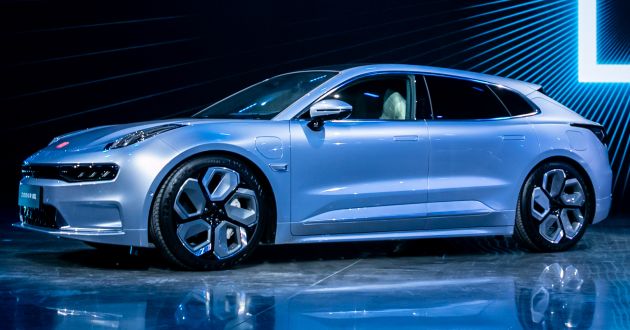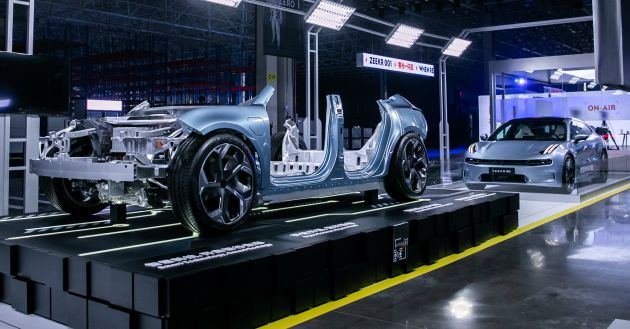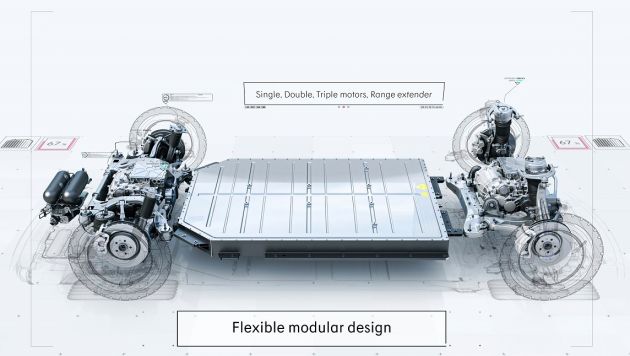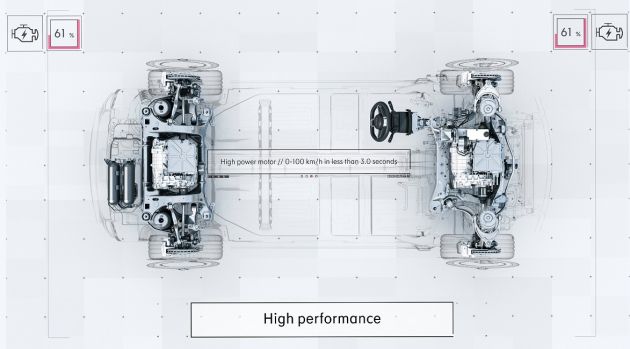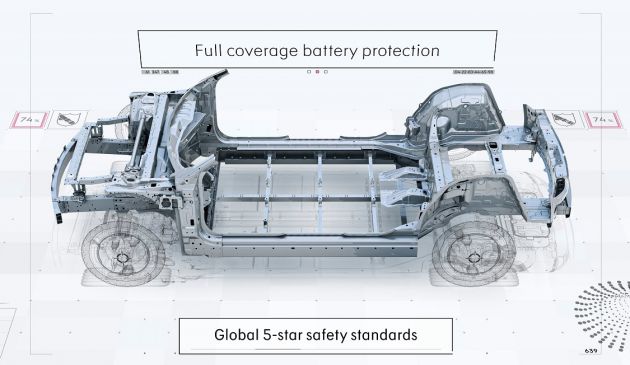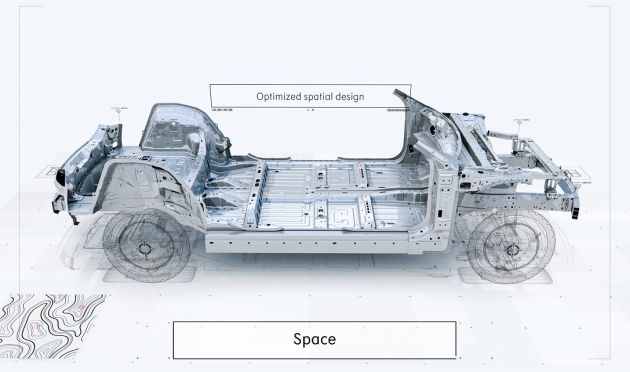Geely is going all in when it comes to electrification with its Sustainable Experience Architecture (SEA), which will underpin a whole range of new electric models. To give us more details about the new platform, the Chinese conglomerate arranged a roundtable session for Malaysian media with SEA’s chief engineer Kent Bovellan, a Swede who previously worked at Volvo.
Bovellan said that SEA will consist of five different versions covering a wide variety of market segments. The core platforms are the SEA1 for large vehicles covering segments D (mid-size) to F (luxury) and SEA2 for B- to D-segment. There will also be a smaller and cheaper SEA Entry (SEA-E) for A-segment and budget vehicles and even an SEA Sport (SEA-S) meant, as the name suggests, for sportier models.
And that’s not all. Geely is also making a play for the commercial EV market with the SEA Commercial (SEA-C) which will underpin vehicles between 3.5 and 5.5 tonnes, including buses with a capacity of up to 12 passengers and pick-up trucks. Smaller commercial vehicles will be able to utilise the other SEA platforms as well, and all models will share a number of common components to cut development costs.
For now, the family of platforms has spawned the SEA1-based Zeekr 001, a coupé-style SUV previously known as the Lynk & Co Zero. There will be a range of new models coming soon, however, including an MPV, a smaller SEA2-based model and a smart SUV developed in partnership with Daimler.
There is a large bandwidth of vehicles being supported here – the wheelbase of SEA2 models currently being developed, for example, range from 2,650 mm to 2,900 mm. Cars being built on the SEA1 will be even larger, with the Zeekr 001 having a wheelbase of 3,005 mm. Bovellan has confirmed, however, that Geely will not be producing small city EVs that are becoming popular in China – not even with the SEA-E platform, on which the smallest model currently being developed has a 2,550 mm wheelbase.
Bovellan also confirmed that all models will feature unibody construction, even commercial vehicles built on the SEA-C platform, with the battery pack being used to strengthen the structure. It would be interesting to see how an SEA-based unibody pick-up would fare in the burgeoning electric truck segment, with the newly-revealed Ford F-150 Lightning being based on the proven body-on-frame F-Series.
The platform is also very versatile, capable of accepting front-, rear- or all-wheel drive through the positioning of single or multiple motors. It also supports the fitment of a range extender, although it won’t take the form of a conventional car engine. Instead, the generator will be small in size and positioned at the rear of the car in place of an electric motor, with the front motor instead powering the vehicle.
All models will be offered with at least two battery options, with SEA-E vehicles being offered with 58 and 68 kWh units and the Zeekr 001 coming with either 86 or 100 kWh in capacity. Bovellan calculates that with a power consumption of 12.5 kWh per 100 km, even the smallest SEA2 battery has a range of around 460 km; the 001, on the other hand, has a quoted range of up to 700 km. With the range extender in place, Bovellan claims a total range of around 1,000 km with a 40 kWh battery and a 40 litre fuel tank.
The SEA platform is also capable of DC high-speed charging, with the SEA1 allowing up to 400 volts to charge the battery from 10 to 80% in around 30 minutes. It can be also be upgraded to an 800-volt system in the future for an even faster charge time of around 20 minutes.
Despite placing the battery under the floor like other carmakers are doing, Bovellan says that the SEA platforms will also be able to accommodate cars as low as 1,480 mm, through measures like repositioning some of the battery cells to the centre tunnel to accommodate lower footwells, as well as using thinner carpeting and seats and a fixed glass roof instead of a sliding one.
This is particularly important for the SEA-S platform, which Bovellan likened to Volkswagen’s Premium Platform Electric (PPE) being jointly developed by Audi and Porsche. Indeed, the former Volvo engineer said that cars built on SEA-S are meant to compete with those from Porsche, which means the architecture will probably spawn a rival to the Taycan, which rides on the PPE’s predecessor, the J1 platform.
Bovellan made big claims about the engineering of SEA, saying that the regular platforms will beat Tesla in almost every area apart from performance, including cost efficiency, NVH, handling, interior space and maintenance costs. The architecture will apparently be lighter than the American competition, despite using a mix of aluminium and steel rather than the pure aluminium construction on the Model S and X.
That’s not to say that SEA vehicles won’t be fast, with the Zeekr 001 being capable of getting from zero to 100 km/h in 3.8 seconds. Bovellan added that those who want more performance can opt for the SEA-S models, with a target acceleration time of around 2.8 seconds. Not quite as fast as the 1.99 seconds achieved by the new Model S Plaid, but then nothing else is.
One big consideration for electric vehicles is the longevity of the battery, and here Geely has rattled off some strong figures. The batteries for the SEA platform, supplied by China’s CATL, are capable of running 200,000 km without any drop in range and can travel up to two million kilometres before the capacity drops to 80%. Bovellan says the highly efficient cooling system helps to reduce battery degradation.
The SEA platform also differentiates itself from its rivals as it’s billed as an “open source” architecture. This means that apart from Geely’s own brands, SEA is also available for other carmakers and even companies outside the core automotive industry to build vehicles on.
Bovellan said that SEA is a true open collaboration, with Geely sharing three-dimensional computer-aided design (CAD) data and other relevant information to its partners. The project is already attracting a number of interested parties – besides Daimler with the smart joint venture, the company is working on building new electric vehicles for Chinese tech giant Baidu.
Geely is also partnering with smartphone maker Foxconn to provide car production, consulting, intelligent driving systems and other services to interested parties. According to Bovellan, its partners have come away impressed with the platform, having tested SEA-based prototypes back-to-back with Tesla vehicles.
So there you have it, a deep dive into all of the latest technical details and developments on Geely’s new SEA platform. What do you think – does the company have what it takes to go toe-to-toe with Tesla and other electric vehicle rivals? Sound off in the comments after the jump.
Source: Read Full Article

